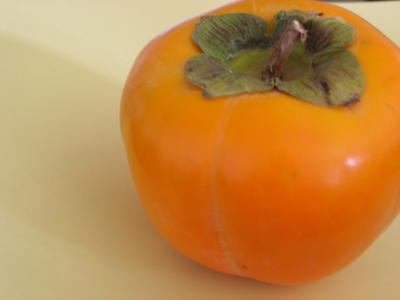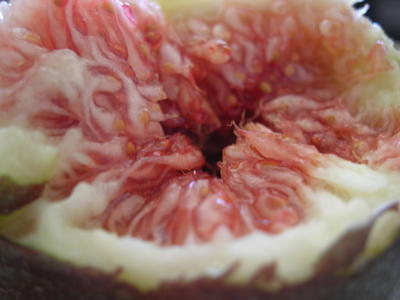
Gorgeous heirloom tomatoes from the Santa Monica Farmers' Market
This year marks the 25th anniversary of the Santa Monica Farmers' Market, and to celebrate, the beautiful new Santa Monica Public Library is hosting a three part discussion series called Farms, Farming, and Farmers' Markets.
This week's discussion addressed the question, "what is the future of California's small farms and how can farmers' markets help keep farmers on their farms?" Laura Avery, who you may recognize from her weekly farmers' market reports on Evan Kleiman's KCRW show Good Food, did an impressive job of moderating the discussion.
Russ Parsons, multi-award-winning food journalist, columnist for the LA Times' Food section, and author of How to Read a French Fry opened the discussion. He believes that we are on the edge of a produce and agriculture revolution. Farmers' markets used to be common, but after the war, the supermarket industry grew and farmers' markets shrank. Now, farmers' markets are coming back with a vengeance, and they've begun to have an impact on the supermarket industry: for example, items that used to be rare have become mainstream, and major grocery stores are starting to provide organic options (Safeway's "O Organics" is one brand).
Farmers' markets give farmers the opportunity to reap a financial reward for doing good work and provide an incentive to grow crops that are outside the mainstream. A traditional farmer selling to a national supplier may make a profit of only a few cents per pound on his peaches, but if he sells directly to his customers via a farmers' market, he can earn a couple of dollars per pound. Similarly, while a national supplier may not pay a farmer enough to make it worth her while to grow tricky produce like Snow Queen nectarines, farmers' market customers will.
Before you start complaining that farmers are taking advantage of their customers and charging ridiculous premiums for their produce, keep in mind that farming, just like real estate, computer programming, or any other business, has significant overhead costs like rent, fuel, labor, and insurance. These things aren't cheap, especially in California. Farmers' market produce reflects the real cost of food--the cost to bring you fresh, sustainably grown produce. Unfortunately, the price does not yet reflect the true labor costs involved in raising food: due to the very high cost of living in California, it is rare that a farmer is able to pay his workers a living wage (keep in mind that most of the businesses you frequent aren't paying their workers a living wage, either).

Persimmon from the Santa Monica Farmers' Market
At the Santa Monica Farmers' Market, customers pay similar prices but get a vastly superior product--one that was picked the day before, at peak flavor and nutritional value. Even at stores like Whole Foods and Wild Oats where we pay a premium for what we think is better produce, that produce has likely been sitting around for up to a week before we even buy it. Add to that the time the produce probably sits around once you get it home, and you have to wonder, "why bother?"
I like to go to the market and buy 2-3 days' worth of produce. I eat most of it within an hour or two of buying it--I can't help myself! I'm not quite sure how the prices compare to, say, Ralphs, but I don't care, either--there is no contest between a Chilean avocado and a California avocado, a green zebra heirloom tomato and one of those mealy pink things, fresh figs and -- oh yeah, the big stores don't tend to sell those.
Phil McGrath of McGrath Family Farms is a fifth generation farmer from Camarillo. He explained how a farmer that sells at a farmers' market has to become both a nutritionist and a chef to be able to answer his clients' questions about the health value and preparation of his produce. He also explained how it was because of his customers' requests for organic produce that he started growing organically. The direct contact between farmer and consumer at the farmers' market makes it much easier for customers to share their wants, needs, and opinions with farmers than the impersonal, multi-level structure of large chain grocery stores does. Alex Weiser, second-generation owner of Weiser Family Farms, is a self-professed seed catalog enthusiast who loves seeking out new and exciting products to bring his customers. Without farmers' markets, however, he would have little incentive to keep at it.
The accessibility of farmers' markets makes them a great venue for change. The Santa Monica Farmers' Market is starting up a zero waste program whereby the utensils and plates that are used to provide samples at the market will be turned into compost in Bakersfield. We tried out the compostable cups after the discussion--they look and act stunningly like ordinary, clear plastic cups.

Brown Turkey Figs from the Santa Monica Farmers' Market
Most people, it seems, don't really know what "organic" means, including members of Thursday's audience--folks more likely than most to be in-the-know on this subject. Maryanne Carpenter of Coastal Farms explained that in order for food to be certified organic, farmers must comply with a bevy of requirements, including time-consuming, labor-intensive documentation and record-keeping processes. For some small farmers like Maryanne, it's more extra work than the farmers can handle. Being certified can add significantly to a farmer's costs, not only due to the fees involved, but also due to the time that is sacrificed to document compliance with regulations and the possible need to hire additional staff to process all the extra paperwork.
She is one of several farmers at the market whose produce is essentially organic but is not allowed to be described that way because the farmer can't or doesn't want to deal with the bureaucracy involved in being certified. Look for words like "sustainably grown," "pesticide-free," and "all-natural," not just "certified organic," when you want to be responsible in your produce choices. At the same time, keep in mind that less scrupulous farmers or their employees (not to mention major corporations) may be willing to feed you the organic line even though it's not true.

Sugar snap peas from the Santa Monica Farmers' Market
I also learned about the market's involvement in our schools. The Santa Monica/Malibu Unified School District has teamed up with the farmers' market to provide a hot lunch alternative in its schools. I'm jealous--I ate PBJ or turkey sandwiches on white bread for most of my childhood. Also, every Wednesday the farmers' market gives tours to schools, and the kids receive a voucher to make a purchase from the market after the tour. I wish I'd had an opportunity like that growing up -- I was raised on Dole mandarin oranges, Chiquita bananas and Red Delicious apples. There were no farmers' markets where I grew up, and the family budget did not support luxuries like Whole Foods' produce. I didn't even like produce until I started going to the Santa Monica Farmers' Market.
Afterwards, we got to enjoy plenty of panini provided by Evan Kleiman of of Angeli Caffe (and the aforementioned Good Food). Fortunately for me, she also serves these sandwiches at her restaurant. I so loved the panini rustico, a heavenly combination of balsamic marinated chicken, arugula, mustard, and raisins that I had four! I made sure other people got their fair share first, of course. (Shame on you for doubting me.) Evan's restaurant is one of fifty-one in Los Angeles that gets its produce from the farmers' market, and the food she provided last night showcased these ingredients. If you've ever been upset that your favorite stand is out of your favorite produce because they've sold it all to a restaurant before you got there, get over it--without the support of chefs, we wouldn't even have the market as we know it. If you'd like to know which restaurants support our markets, stay tuned--I'll be providing the information on Foodie Universe next week after I pick up a flyer at Wednesday's market.
If you're interested in learning more about Southern California's best farmers' market and its farmers, the next two sessions will be held on August 17th and September 21st from 7:00-9:00 pm. Meet in the MLK Auditorium at the Santa Monica Public Library (main branch), located at 6th St. and Santa Monica Blvd.
By the way, if you haven't been to the new library yet, you have to go! It's the most beautiful, peaceful, sunny library I've ever seen--and it's a green building, too! Arrive early if you can and check it out.
No comments:
Post a Comment